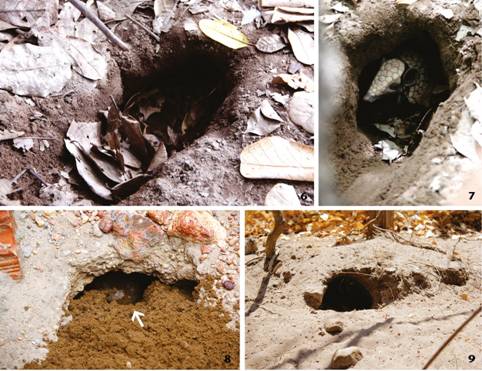ABSTRACT
It is believed that the two species of Tolypeutes Illiger, 1811are the only armadillos that do not dig their own burrows, and that these species simply re-use burrows dug by other species. Here, we show that Tolypeutes matacus (Desmarest, 1804) and Tolypeutes tricinctus (Linnaeus, 1758) dig their own burrows. We describe the burrows and three other types of shelters used by them, and provide measurements and frequency of use of the different types of shelter. We have studied free-ranging individuals of T. matacus in two locations in Central Brazil and individuals of T. tricinctus in semi-captivity in the Northeast of Brazil. Individuals of T. matacus were found primarily in small burrows (76%), straw nests (13%), shallow depressions covered with leaf-litter (7%) or in straw nests made on shallow depressions (4%). Adult males and females of T. matacus did not differ in frequency of use of different types of shelter. Sub-adults T. matacus used shallow depressions and nests more often (40%) than adults (22%) and nurslings (10%). Nurslings of T. matacus reused the shelters more frequently (66%), than sub-adults (46%) and adults (35%). Adult females reused burrows and other types of shelter more frequently than adult males. Tolypeutes tricinctus rested mainly in burrows and under leaf-litter, but did not dig depressions or build nests. Tolypeutes tricinctus occasionally used burrows dug by Euphractus sexcinctus (Linnaeus, 1758), but T. matacus never used burrows dug by other species. Nursling T. matacus always shared shelter with an adult female therefore, both used shelters with similar frequency. Adult females and nurslings of T. matacus reused shelters in higher frequency. That can be explained by the fact that adult females with offspring tend to remain for consecutive nights in the same burrow when cubs are recently born. Due to their smaller body size, sub-adult T. matacus used shelter strategies that require less energetic effort more frequently than adults and nurslings. The habit of covering the burrow entrance with foliage and the burrow's reduced depth, indicates that Tolypeutes use of burrows is more likely to be related to parental care behavior and thermoregulation strategies than to defense mechanisms. We are confident that the burrows used for resting were indeed dug by Tolypeutes because, besides the direct observation of armadillos digging burrows, the measures of the burrows are very distinctive from those presented as characteristic for the co-occurring burrowing species and are congruent with Tolypeutes size and carapace shape. The newly acquired knowledge that species of Tolypeutes dig burrows can be used to increase the well-being of individuals kept in captivity by adapting enclosures to enable their digging behavior. In addition, this information contributes not only to the study of the ecology and natural history of the species, but can shed new light on the study of the anatomy of specialized diggers. Tolypeutes spp. can comprise the least fossorial of all living armadillo species, but they can no longer be classified as non-diggers.
KEY WORDS:
Digging behavior; ecology; Xenarthra

 Thumbnail
Thumbnail
 Thumbnail
Thumbnail
 Thumbnail
Thumbnail


